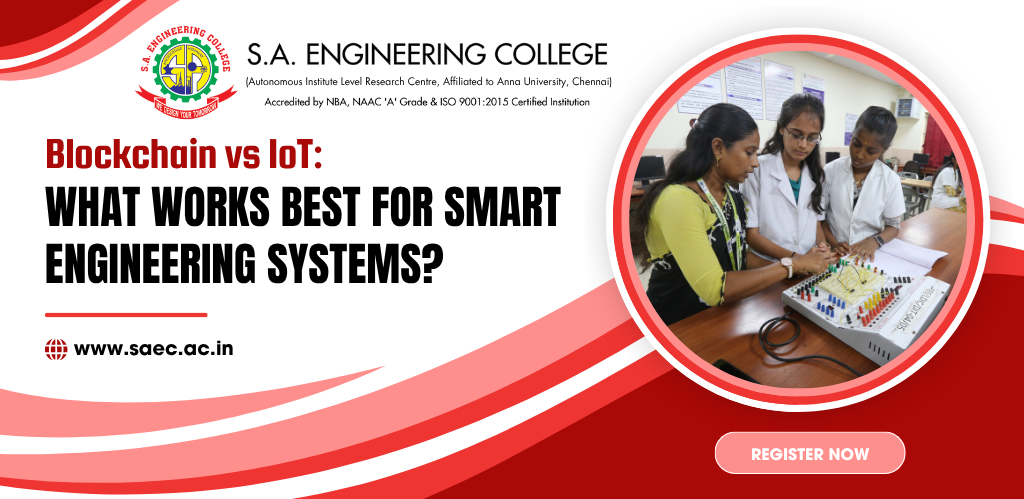
Blockchain vs IoT: What Works Best for Smart Engineering Systems?
Introduction: The Age of Smart Engineering
The convergence of advanced technologies is transforming the engineering landscape. Among the most influential forces driving this transformation are Blockchain and the Internet of Things (IoT). Both technologies promise smarter, safer, and more efficient engineering systems—but when it comes to implementation, engineers often ask: Which works better for smart engineering systems—Blockchain or IoT?
This blog delves deep into each technology, their respective roles in engineering, where they intersect, and when one might be better than the other depending on the use case.
Understanding the Core Technologies
What is Blockchain?
At its core, blockchain is a decentralized digital ledger. It records data across a network of computers in a way that ensures transparency, immutability, and security. Once data is entered into a blockchain, it cannot be altered without consensus from the network—making it ideal for recordkeeping, verification, and secure transactions.
Key features:
- Decentralization
- Immutability
- Cryptographic security
- Smart contracts
What is IoT (Internet of Things)?
The Internet of Things refers to a network of interconnected devices that collect, share, and act on data. From sensors in bridges to smart thermostats in buildings, IoT enables real-time monitoring and autonomous decision-making in engineering environments.
Key features:
- Connectivity
- Real-time data collection
- Remote monitoring and control
- Automation through AI/ML integrations
Comparing Blockchain and IoT: Core Strengths in Engineering Systems
When comparing Blockchain and IoT within smart engineering systems, each technology offers distinct strengths suited for different objectives.
Data Management: Blockchain excels in securely storing tamper-proof data records, ensuring that once information is logged, it cannot be altered without consensus. In contrast, IoT is designed for real-time data generation, offering instant insights and operational feedback critical to fast-paced environments.
Connectivity: Blockchain operates through peer-to-peer nodes that validate and store data collaboratively, while IoT relies on device-to-device communication that facilitates immediate information exchange across machines and sensors.
Security: Blockchain provides strong cryptographic protection and is highly resistant to tampering, making it ideal for environments that require high trust and transparency. IoT, on the other hand, is more vulnerable to cyberattacks, especially if devices are not protected with the latest security protocols.
Efficiency: IoT systems are efficient and fast, especially when handling large volumes of data in real-time. Blockchain can be slower due to consensus mechanisms like proof-of-work or proof-of-stake, which ensure data validity but introduce latency.
Scalability: IoT can support millions of interconnected devices across expansive networks, making it highly scalable. Blockchain, however, often faces limitations due to block size and transaction speed, which can hinder large-scale real-time applications.
Best Use Case: Blockchain is best suited for scenarios involving data integrity, audit trails, and supply chain verification, while IoT shines in use cases that demand real-time control, automation, and continuous monitoring.
IoT in Smart Engineering Systems
IoT has been a game-changer in engineering, particularly in predictive maintenance, resource optimization, and remote diagnostics.
Real-World Applications:
- Smart Manufacturing – IoT sensors monitor equipment health and performance, reducing downtime and enhancing productivity.
- Civil Engineering – Smart sensors embedded in bridges and roads detect stress, cracks, and vibrations.
- Building Management Systems (BMS) – Real-time monitoring of HVAC, lighting, and energy systems.
Advantages:
- Instant data feedback
- Integration with AI for predictive insights
- Automation of repetitive tasks
- Energy and cost savings
- However, IoT comes with significant security challenges, such as:
- Data privacy concerns
- Vulnerability to hacking
- Centralized data storage risks
Blockchain in Smart Engineering Systems
Blockchain addresses many of the challenges posed by IoT, especially around security, traceability, and data verification.
Real-World Applications:
- Construction and Supply Chain Management – Blockchain tracks the origin, quality, and delivery of materials, reducing fraud.
- Smart Contracts in Engineering Projects – Automated agreements trigger payments or approvals upon meeting certain milestones.
- Data Integrity in IoT Devices – Secures data logs to prevent manipulation and prove authenticity.
Advantages:
- Immutable data records
- Transparency across stakeholders
- Enhanced security for IoT data
- Reliable audit trails
- However, blockchain has its own limitations:
- High energy consumption (especially in PoW systems)
- Slower transaction times
- Not ideal for large-scale, real-time data handling
Where They Converge: Blockchain + IoT
The most promising engineering systems often involve the integration of Blockchain and IoT, creating a synergistic system where each addresses the other’s weaknesses.
Use Cases of Integration:
Smart Cities – IoT collects traffic, air quality, and energy usage data. Blockchain secures this data and facilitates automated governance.
Industrial Automation – IoT monitors factory conditions, and Blockchain verifies and logs each stage of the production cycle.
Utility Management – Water and electricity meters send data via IoT, while blockchain records usage history for billing and compliance.
Benefits of Combining Both:
- IoT enables real-time actions.
- Blockchain ensures security and transparency.
- Together, they reduce fraud, boost trust, and enhance system resilience.
When to Use Blockchain Over IoT and Vice Versa
Use Blockchain When:
- Data integrity and provenance are critical (e.g., compliance, contracts).
- You need secure, transparent records of activities (e.g., audit trails).
- You want to decentralize trust among stakeholders.
Use IoT When:
- Real-time monitoring or automation is needed (e.g., sensors, BMS).
- You want to streamline processes through immediate data collection.
- Operational speed and volume are more important than data immutability.
Use Both When:
- You need a system that is both smart and secure.
- You’re working on projects involving multiple parties and devices.
- You’re managing large infrastructures (e.g., smart grids, ports, airports).
Limitations and Challenges
IoT has been a game-changer in engineering, particularly in predictive maintenance, resource optimization, and remote diagnostics.
IoT in Smart Engineering Systems
IoT Challenges:
- Security risks due to unsecured endpoints
- Complex network management
- High costs for maintenance and scalability
Blockchain Challenges:
- Not suitable for time-sensitive actions
- Storage limitations for massive IoT datasets
- Regulatory uncertainty in some regions
Future Outlook: Toward Smart, Secure, and Scalable Systems
The future of engineering will not be a Blockchain vs IoT scenario, but rather a Blockchain + IoT paradigm. Emerging architectures now explore:
- Edge computing to handle real-time IoT data processing
- Lightweight blockchain protocols tailored for IoT networks
- AI-integrated systems that learn and adapt autonomously
As both technologies evolve, they’ll underpin next-gen smart engineering systems—from autonomous infrastructure to digitally verified smart contracts—redefining efficiency, safety, and transparency.
Conclusion: Which Works Best?
The answer depends on your objectives, scale, and risk profile.
If your focus is real-time operations and automation, IoT is indispensable.
If your priority is security, traceability, and trust, Blockchain excels.
For truly smart and resilient systems, the integration of both will yield the best results.
Smart engineering isn’t just about innovation—it’s about choosing the right tools for the right challenges. Blockchain and IoT each bring unique strengths to the table. Harnessing both will unlock the future of engineering.


